This article, “Why is my Monstera leaves turning yellow,” will cover some reasons behind Monstera leaves yellowing and expert tips on how to fix it in no time. Read on to discover:
- An overview of Monstera plants and Monstera’s leaves.
- The reasons behind Monstera leaves yellowing.
- How to fix Monstera leaves from turning yellow.
- Important things to know about Monstera plant’s leaves.
- Answers to common questions about yellowing leaves.
Monstera Leaves Turn Yellow
Monsteras are among the most popular houseplants, and various factors contribute to their massive attraction, ranging from the well-known Monstera Deliciosa to Adansonii.
Unfortunately, Monstera plants don’t always look as pleasing as they do on Instagram or Pinterest feeds—they frequently experience issues, including their leaves turning yellow.
Below, we will go through different factors that might cause the Monstera leaves to turn yellow, as well as the fastest approach to fix or avoid the issue in the long term.
Prevention is better than the cure – as they say.
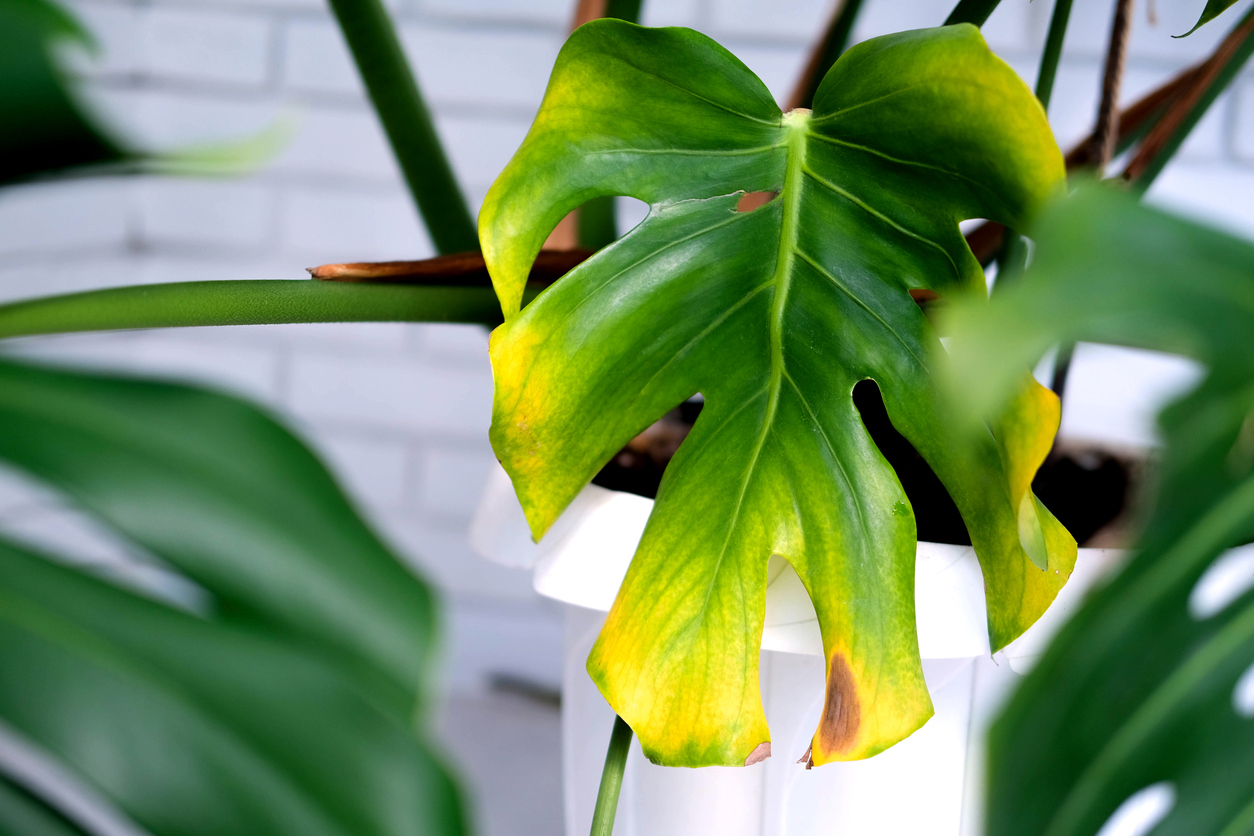
Why Are My Monstera Leaves Turning Yellow?
Monsteras are tropical plants distinguished by their intricately shaped leaves. Since wild seedlings thrive best in partly to fully shaded environments, it’s common to find them indoors.
To guarantee that your Monstera flourishes, it is essential to establish the ideal combination of light, temperature, watering, and feeding—as is the case with all indoor plants.
Typically, the Monstera Deliciosa leaves may turn yellow for several reasons, such as inappropriate temperature, overwatering, improper light, low humidity, and fungal infections.
Reason #1 — Watering Considerations
What’s a fool-proof way to nurture a houseplant? Proper watering. However, while watering a plant seems simple, doing it the wrong way may cause severe harm to your Monstera plant.
Since Monsteras don’t react well to improper soil moisture or wet feet, when the leaves begin to turn yellow, overwatering (excess water) is one of the most prevalent causes of this issue.
Even worse, prolonged wet soil often causes yellowing leaves, followed by root rot, and ultimately, the plant’s death. In some cases, drainage holes in the bottom may be helpful.
On the other side, yellowing leaves may also be caused by underwatering or overly dry soil, leading to poor root development. (smaller above-ground growth and lower yields).
Generally, the plant cannot absorb nutrients or produce oxygen via photosynthesis during such a condition. Due to this, there is insufficient chlorophyll, which causes yellow leaves.
Reason #2 — Poor Light Conditions
Native to the tropical regions of South and Central America, Monstera plants thrive best in bright indirect sunlight. However, too much direct sunlight may result in brown leaf edges.
Let the Monstera plant get a few hours of direct sunlight early in the morning. If not possible, use mirrors to reflect direct sunlight into the chamber.
Similarly, the leaves may become yellow if the Monstera plant is subjected to too much light or too little light. Therefore, bright but indirect light is ideal for the plant’s healthy new growth.
Ensure that your Swiss cheese plant is at least 2-3 feet away from any south-facing window during the winter (or if you reside south of the equator, the one that faces north).
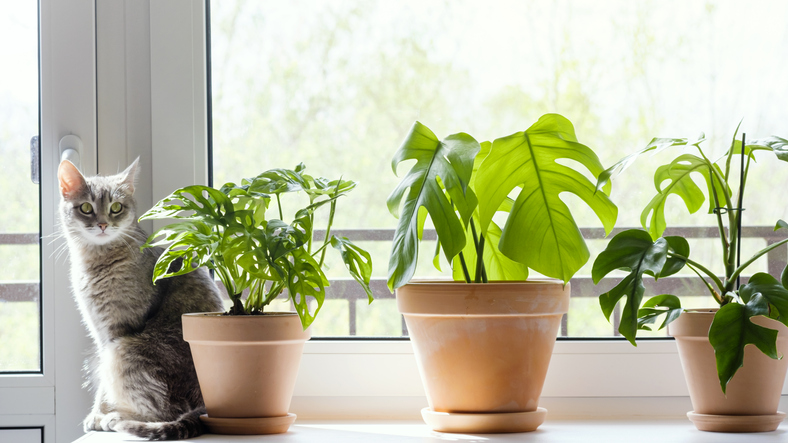
Reason #3 — Pests and Diseases
Unfortunately, dealing with pests and diseases is among the most common issues that nearly all plant parents have to deal with, and the same is the case with Swiss cheese plant owners.
Like most house plants, the Monstera plant or, more specifically, the Swiss cheese plant leaves are exposed to attacks from pests and diseases, which may cause them to turn yellow.
Monstera’s leaves turning yellow may be attributed to the feeding of sap-sucking insects such as mealybugs, spider mites, and aphids, followed by powdery mildew and fungus gnats.
Root diseases are often seen in root-bound plants with constricted roots or soils with inadequate drainage. Some common root diseases include root rot or root nematodes.
If they are not eradicated in the early stages, pests and diseases quickly multiply and spread all over the front portions, hiding in the crevices. This is particularly true if your Monstera is already unwell due to insufficient sunlight, nutrient deficiency, or fungal leaf spots.
Generally, the Monstera plant loses its moisture due to pests and diseases, which causes the fronds and dark green leaves to turn yellow—changing the pattern in which the plant grows.
One easy way to control pests and diseases is to spray the affected plant or leaves with insecticidal soap, neem oil, alcohol, or other pesticides from your local nursery.
Reason #4 — Fertilization
Owing to slower growth tendencies, most houseplants don’t demand excessive fertilizer; the Monstera plant may benefit from periodic feeding with a nitrogen-rich mix composite.
Since Monstera is mostly a foliage plant, it will benefit from nitrogen, which helps maintain the leaves’ beautiful appearance and ensures they remain green and vibrant.
However, this should be done as little as possible and with caution since too much fertilizer may damage the roots and stems of the tropical plant and cause yellow leaves.
As a general rule of thumb, a balanced, water-soluble fertilizer or a light mixture of nitrogen-rich fertilizer should be used yearly, right before the growing season (the warmer months).
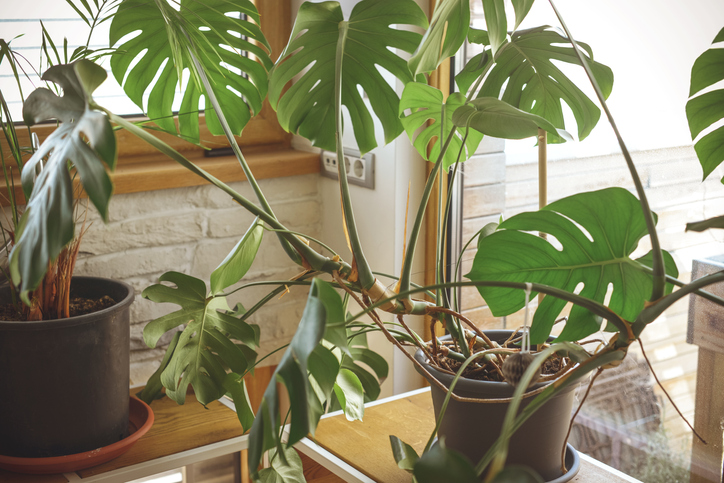
Reason #5 — Temperature and Humidity
When cultivated indoors, Monstera plants need both the temperature and humidity to be kept at a steady, moderate level. If not, you may experience that the leaves are turning yellow.
If the temperature is on the low side, the growth of the Monstera may be stifled, and it may not be able to survive. On the flip side, the plant dries out and perishes if the temperature is too high.
Monstera plants like warmer settings throughout the winter, but they must be allowed to dry out, which may be a problem with heating. Humidity must also be kept at a constant level.
During the winter, when there may be less moisture indoors than usual, giving the Monstera plant a once-daily spritz with water might be helpful to speed up the natural process.
Note that the lack of humidity will first cause the edges of the leaves to turn brown, and subsequently, the whole Monstera leaf will turn yellow, followed by brown spots.
To raise the relative humidity around the Monstera plant, spritz the leaves with water frequently or place a tray of stones in the water underneath the potting soil container..
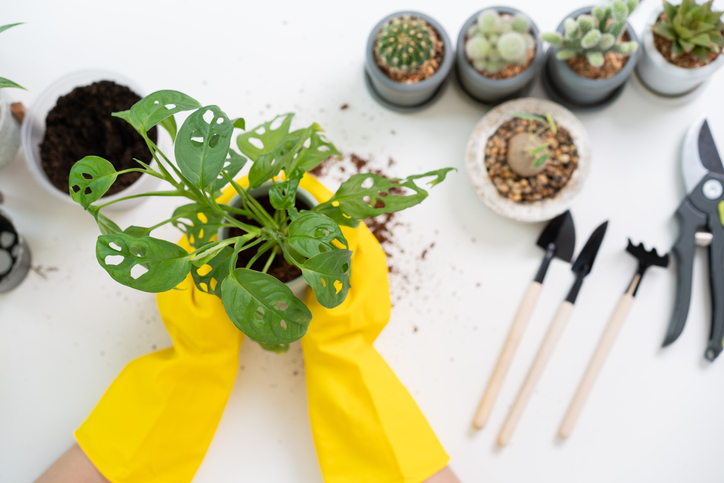
Reason #6 — Transplant Stress
Transplant stress, also known as transplant shock, refers to a range of stressors that may arise in trees and shrubs that have just recently been moved to or repotted in a new location.
If you see wilting leaves, leaf rolling or curling, or your Monstera leaves turning yellow right after repotting, this may signify transplant stress or transplant shock.
Several potential causes of transplant stress include transplanting the Monstera plants at the wrong time of year, relocating to a new fresh soil type, root rot, or an incorrect soil pH.
You may take care of the Monstera plant by ensuring it has drainage holes, repositioning it to the spot where you had it before, or removing any dying leaves that have fallen off.

Reason #6 — Plant’s Age
Not every Monstera leaf yellowing should concern you since certain leaves turn yellow as a natural process with age, which may signify that the Monstera plant is getting old.
Generally, yellow leaves may appear at the base of tropical plants. When it comes to Monstera, the plant naturally drops dying leaves as it directs its energy toward developing new growth.
Reason #7 — Potting Mistakes
Monsteras generally outgrow their pot fairly frequently, and like other plants, if not repotted in a container on time, the plant may be root bound, leading to yellowing leaf/yellow leaves.
Repotting Monstera semi-regularly as it grows may help avoid yellowing leaves. If you’re already facing the issue of yellow Monstera, you must repot the plant and loosen the root ball.
Using a knife to break the root ball apart may be essential in cases of root bound caused by significant reasons; however, only resort to this method if you cannot split the roots by hand.
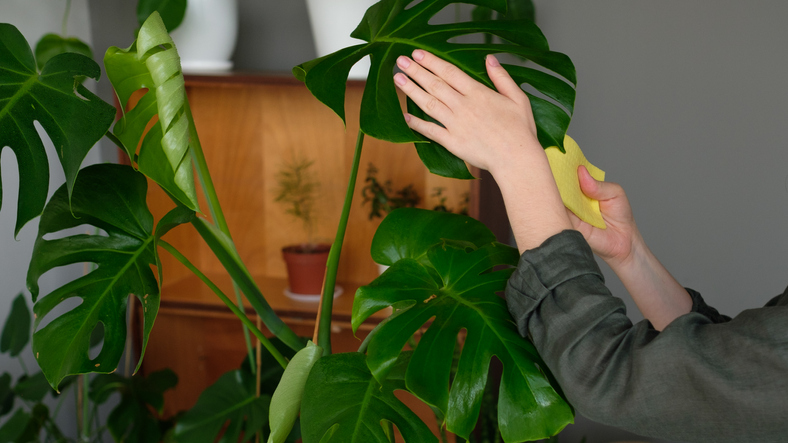
How Do You Fix Yellow Monstera Leaves?
The first step in developing an effective treatment for Monstera yellowing leaves and getting the plant and leaf veins back to a healthy state is to pinpoint the origin of the problem.
Look at the reasons behind yellow Monstera leaves mentioned above and determine which cause suits your plant’s growth condition. Once that’s sorted, it’s time to fix the yellow leaves.
Fix #1 — Provide Optimal Lighting Conditions
If you think the yellow leaves were caused due to poor light conditions, installing an artificial light to provide supplementary light may be your best bet. To save the Monstera leaves from direct natural light, try to move the plant away or install window drapes to filter UV rays.
Fix #2 — Avoid Overwatering At All Costs
If your Monstera leaves turning yellow are a sign of overwatering, causing excess moisture or soil moisture, immediately slow down the regular watering frequency from daily to once a week. Additionally, transfer the plant to a pot with drainage holes to fix the issue for the long term.
Fix #3 — Apply Pest Control Measures
If the Monstera leaves are turning yellow due to sap-sucking insects such as mealybugs, spider mites, and aphids, apply mechanical controls, natural insecticides, or horticultural oils to keep them at bay. If nothing works, simply prune yellow monstera leaves with a pruning shear.
Fix #4 — Leach Out Excess Fertilizer Salt
If Monstera leaves are turning yellow due to an overabundance of fertilizer salts in the soil, consider utilizing water as a leech (sponge) to remove excess nutrient salts. For the greatest possible effect on the entire leaf (yellow leaf), ensure you repeat the steps consecutively.
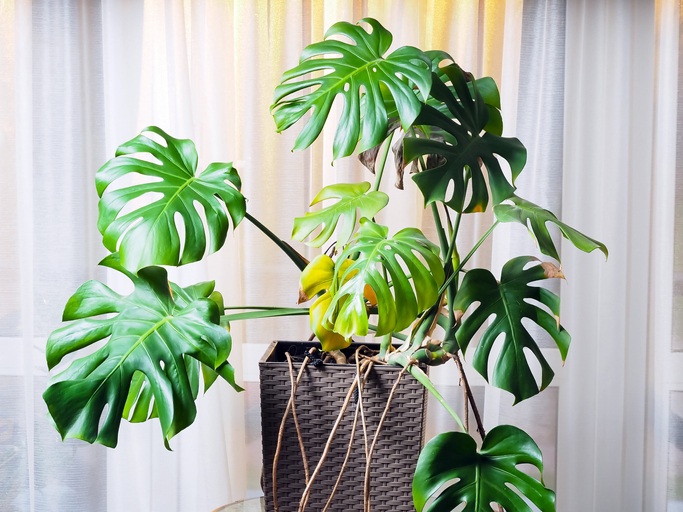
Frequently Asked Questions
Whether you’re planning to fix yellowing leaves in your dying Monstera collection or feeding your brain with general information on yellowing leaves, we hope this article helped.
Here are some frequently asked questions about Monstera leaves turning yellow.
-
How Do You Fix Monstera Yellow Leaves?
The first step in developing an effective treatment for Monstera yellowing leaves and getting the plant back to a healthy state is to pinpoint the origin of the problem. (Read above).
-
Why Did My Monstera Turn yellow?
Typically, Monstera leaves may become yellow for several reasons, such as inappropriate temperatures, overwatering, low light conditions and humidity, and fungal infections.
-
Can Yellow Leaves on Monstera Turn Green Again?
A yellow leaf can’t return to its original green color once it has become yellow. You can chop out the yellow and brown bits and keep just the green part if it doesn’t appeal to you.
-
Can You Save a Yellowing Monstera?
If you wish to save a yellowing Monstera, simply invest in a pot/container with holes for drainage to help the plant with excess moisture before it turns the entire plant yellow.
-
How to Tell If Yellowing Monstera is Natural?
The yellowing of the leaves on your Monstera plant is normal if there is a new development, and the yellowing leaves are older, especially those at the bottom of the plant.
-
How Long Do Monstera Leaves Last?
Monstera leaves, often referred to as Swiss Cheese leaves, normally last between 1-3 weeks. The leather-like leaves enable the water to evaporate sluggishly, contributing to its growth.

My name is Daniel Elrod, and I have been houseplant love ever since I was 17. I love how much joy they bring to any room in the home. I’ve always been amazed at how a few pots of flowing leaves can turn a drab and sterile office into an inviting place where people love to work at.






